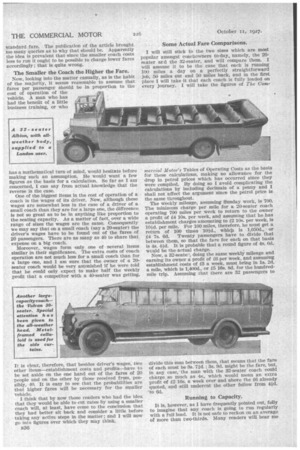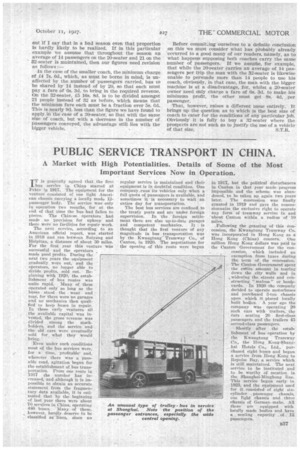INCREASING PROFITS BY BETTER COACH SELECTION.
Page 61

Page 62

Page 63

If you've noticed an error in this article please click here to report it so we can fix it.
Choosing the Size of the Motor Coach for Next Season.
THIS is a time when the coach owner. should be trying to follow that curious recommendation which
• was at one time widely advertised by the "Safety First" Association, namely, to "look both ways." He may accomplish this seemingly difficult feat (in the sense that I have in mind) by attacking it mentally. Moreover; he need not do it all at once, for he has to look back at the season just past and forward at the season to come. He may evn look a little nearer than the corning season ; he may be considering the Commercial Vehicle Show and what he is going to do in the matter of selecting a new coach for next year. At any rate, he is looking back on the season just past to learn' from it how he ought to proceed next season, in order that it may be at least as profitable and preferably
more so. If he be buying h new coach the lessons of last season's operation will be extremely useful, provided he be able to apply thein.
Where Experience Does Not Avail
All sorts of things must pass through his mind, all sorts of queries will crop up, and he will find that even experience of _many seasons does not always provide guidance for those to come. There are many things which May happen and which he can foresee, but which are outside this experience so far as it has gone.
An outstanding problem which often enough cannot be solved" by individual experience is that of selecting the right size of coach, of choosing the one with the seating capacity which is most appropriate for the work to be done, viewing the matter, of course, from an economic and profit-taking point, of view. If a man hitherto has only owned one size, he will lack the knowledge necessary to enable him to judge whether that sizeis best or not. It may be the case that he has found it to be sufficiently profitable. In that event he is, perhaps, best advised to carry on as before, buying a new one of the same.size. I have yet, however, to meet • anyone so happily circumstanced as to be completely . satisfied with what he is earning, nor ndesirous of looking around to see if lie cannot do better. Indeed, it is almost certain that practically every reader of these notes has his doubts as to whether he is making the most of his business opportunities, and that all of them will read with interest what I have to say with regard to this particular problem. ' • Apart from all else, there is nearly always competi tion to be faced, and if a man finds that a com petitor who has a smaller or a larger coach is undercutting him on the same class of work, then the problem 4s by way of becoming acute, for one of the things he will want to know is whether that man is finding it possible to cut rates simply and solely because of the seating capacity of his vehicle.
The bearing which the seating capacity of a coach has on a matter of this kind was emphasized in an article which I wrote a few weeks ago. It dealt with an extreme case of fare cutting : so low a rate as 2s. return being quoted for an 80-mile journey from London to Brighton and back. In the course of investigating that case, it became clear that, whilst a man with a 32-seater might safely cut the prevailing rate (although not to any great extent), the owner of a 20-seater—and he, of course, was the man who was actually doing the cutting—was actually working at a loss 'even at the standard fare. The publication of the article brought me many queries as to why that should be. Apparently the idea is prevalent that since the smaller coach costs less to run it ought to be possible to charge lower fares accordingly ; that is quite wrong.
The Smaller the Coach the Higher the Fare.
Now, looking into the matter casually, as is the habit of the majority, it seems reasonable to assume that fares per passenger should be in proportion to the cost of operation of the vehicle. A man who has had the benefit of a little business training, or who
has a mathematical turn of mind, would hesitate before making such an assumption. He would want a few figures as the basis for a calculation. So far as I am concerned, I can say from actual knowledge that the reverse is the case.
One of the biggest items in the cost of operation of a coach is the wages of its driver. Now, although these wages are somewhat less in the case of a driver of a small coach than they are for a large one, the difference is not so great as to be in anything like proportion to the seating capacity. As a matter of fact, over a wide range of sizes the wages are the same. Consequently we may say that on a small coach (say a 20-seater) the driver's wages have to be found out of the fares of 20 passengers. There are as many as 40 to share that expense on a big coach.
Moreover, wages form only one of several items similar in their significance. The extra costs of coach operation are not much less for a small coach than for a large one, and I am sure that the owner of a 20seater coach would he very astonished if he were told that he could only expect to make half the weekly profit that a competitor with a 40-seater was getting.
It is clear, therefore, that besides driver's wages, two other items—establishment cosh. and profits—have to be set aside on the one hand out of the fares of 20 people and on the other by those received from, possibly, 40. It is easy to see that the probabilities are that higher fares will be necessary for the smaller vehicle.
I think that by now those readers who had the idea that they would be able to cut rates by using a smaller coach will, at least, have come to the conclusion that they had better sit back and consider a little before taking any active steps in the matter ; and I will now go into figures over which they may think.
B36
Some Actual Fare Comparisons.
I will still stick to the two sizes which are most popular amongst coachowners to-day, namely, the 20seater ard the 32-seater, and will compare them. I will assume it to be the case that each is running 100 miles a day on a perfectly straightforward job, 50 miles out and 50 miles back, and in the first place I will take it that each coach is fully loaded on every journey. I will take the figures of The Corn mereial Motor's Tables of Operating Costs as the basis for these calculations, making no allowance for the drop in petrol prices which has occurred since they were compiled. By doing so I avoid complicating the calculations by including decimals of a penny and I shall not affect the argument since the petrol price is the same throughout.
The weekly mileage, assuming Sunday work, is 700. The minimum charge per mile for a 20-seater coach operating 700 miles per week to return to the owner a profit of £4 10s. per week, and assuming that he has establishment charges amounting to 12 10s. per week, is 101d, per mile. For 100 miles, therefore, he must get a return of 100 times 103d., whicji is 1,050d., or £4 7s. 6d. Twenty passengers have to divide that between them, so that the fare for each on that basis is 4s. 41d. It is probable that a round figure of 4s. 6d. would be the actual charge.
Now, a 32-seate', doing the same weekly mileage and earning its owner a profit of £6 per week, and assuming establishment costs of £3 a week, must bring in is. 2d. a mile, which is 1,400d., or £5 16s. 8d. for the hundredmile trip. Assuming that there are 32 passengers to divide this sum between them, that means that the fare of each must be 3s. 71d.; 3s. 9d. might be the fare, but, in any case, the man with the 32-seater coach could charge so much as 4s., which would mean an extra profit of £2 16s. a week over and above the £6 already quoted, and still undercut the other fellow from 41d. to 6d.
Running to Capacity.
It is, however, as I have frequently pointed out, folly to imagine that any coach is going to run regularly with a full load. It is not safe to reckon on an average oi more than two-thirds. Many readers will bear me out if I say that in a bad season even that proportion is hardly likely to be realized. If in this particular example we assume that throughout the season an average of 14 passengers on the 20-seater and 21 on the 32-seater is maintained, then our figures need revision as follows :— In the case of the smaller coach, the minimum charge of £4 7s. 6d., which, as must be borne in mind, is unaffected by the number of passengers carried, has to be shared by 14 instead of by 20, so that each must pay a fare of Os. 3d. to bring in the required revenue. On the 32-seater, £5 16s. 8d, is to be divided amongst 21 people instead of 32 as before, which means that the minimum fare each must be a fraction over 5s. Ed. This is nearly 9d. less than the figure we have found to apply in the case of a 20-seater, so that with the same size of coach, but with a decrease in the number of passengers conveyed, the advantage still lies with the bigger vehicle. Before commiGing ourselves to a definite conclusion on this we must consider what has probably already occurred to a good many of our readers, namely, as to what happens supposing both coaches carry the same number of passengers. If we assmite, for °example, that while the 20-seater 'carries an average of 14 passengers per trip the man with the 32-seater is likewise unable to persuade more than 14 people to use his coach, obviously, in that case, the man with the. bigger machine is at a disadvantage, for, whilst a 20-seater owner need only charge a fare of Os. 3d. to make his minimum profit, the other must get 8s. 4d.• per passenger.
That, however, raises a different issue entirely, it brings up the question as to which is the best size of coach to cater for the conditions of any particular job. Obviously it is folly to buy a 32-seater where the prospects are not such as to justify the use of a vehicle' of that size. S.T.R.




















































































































